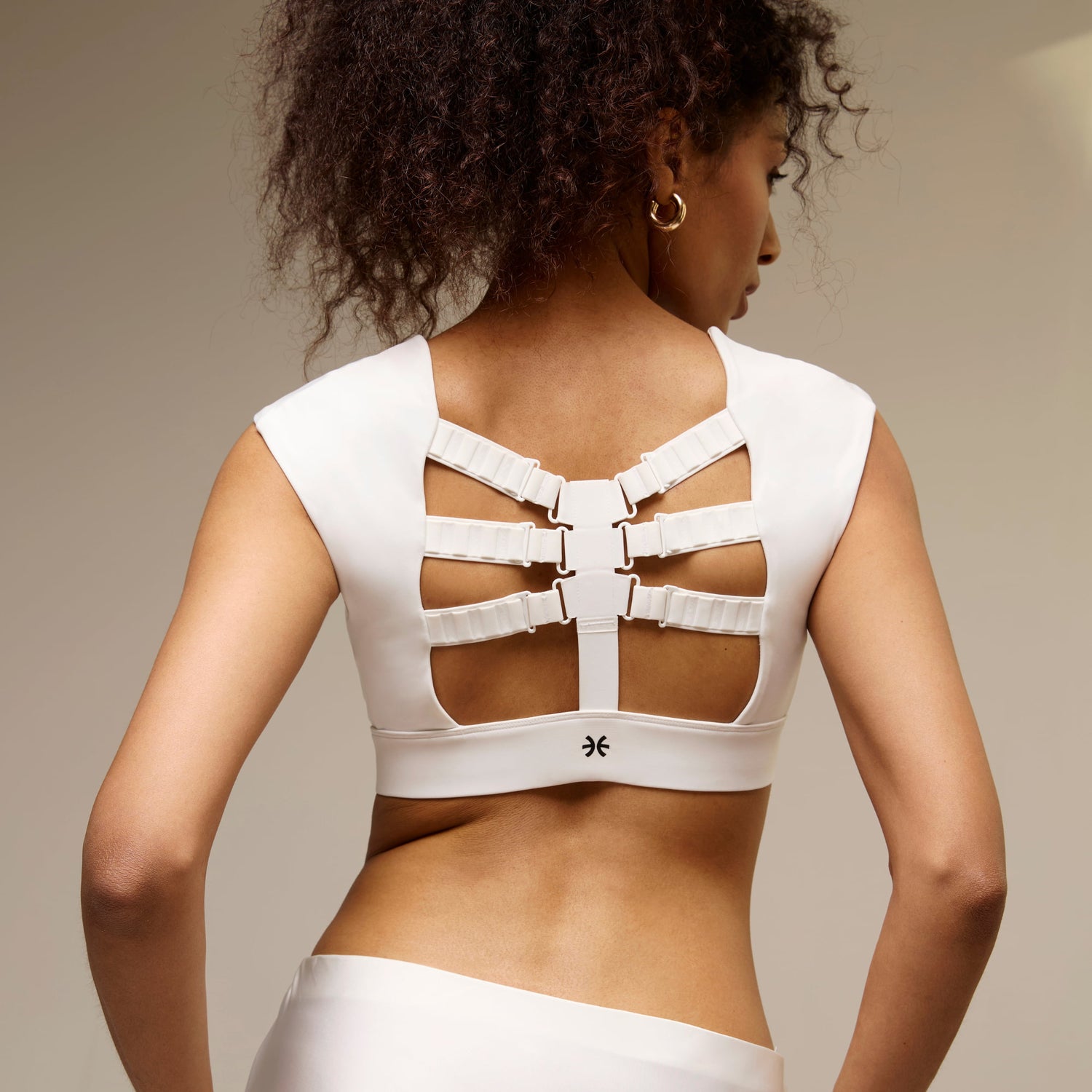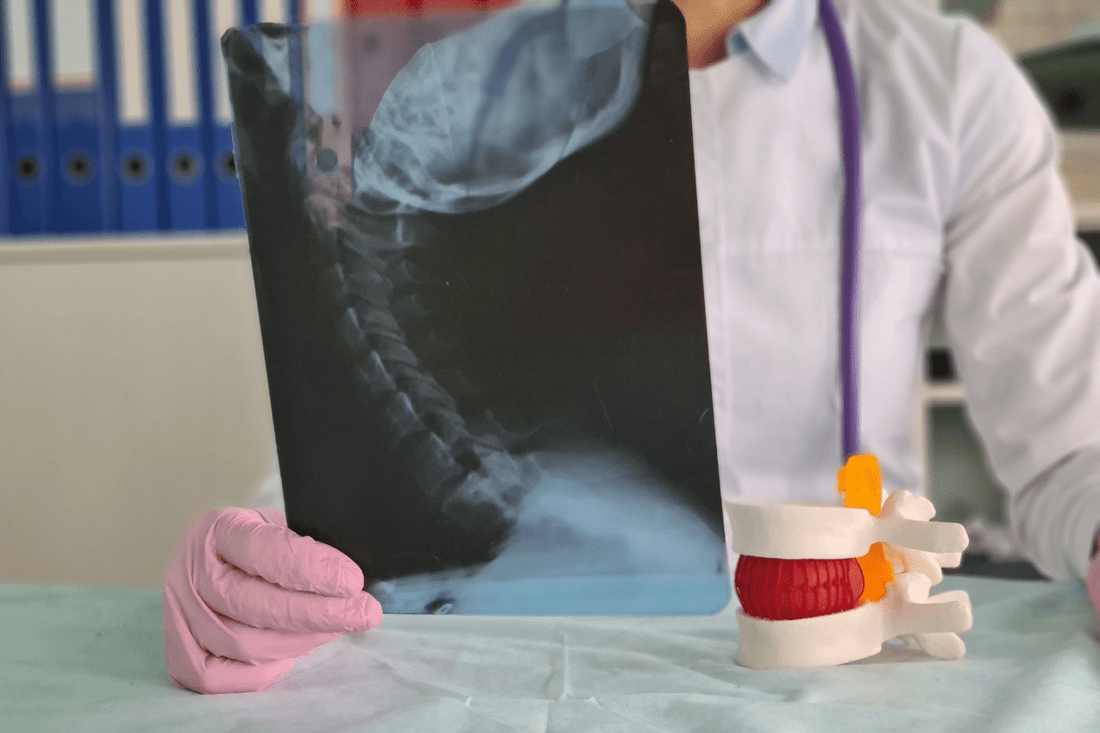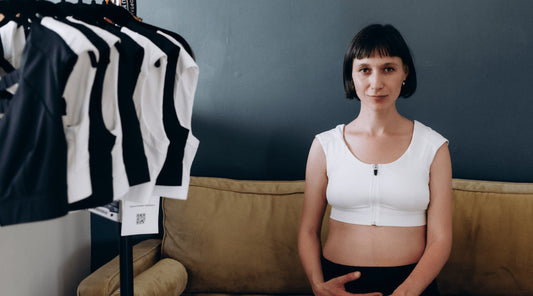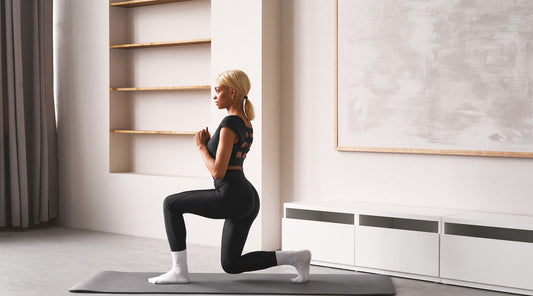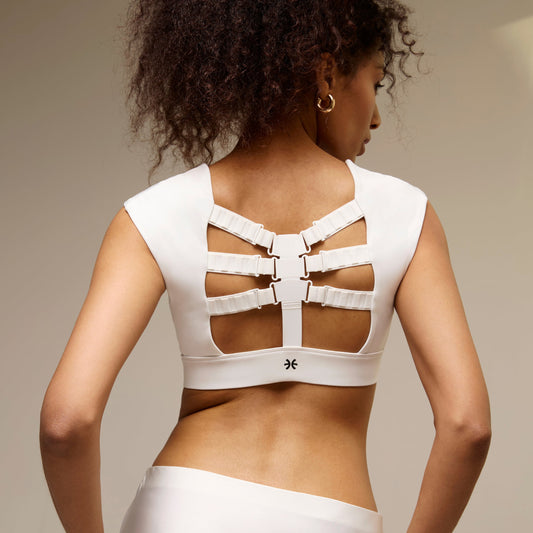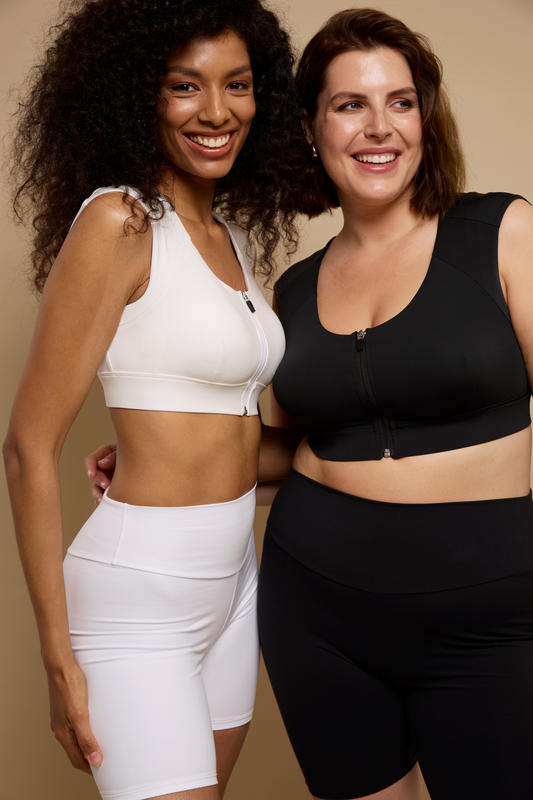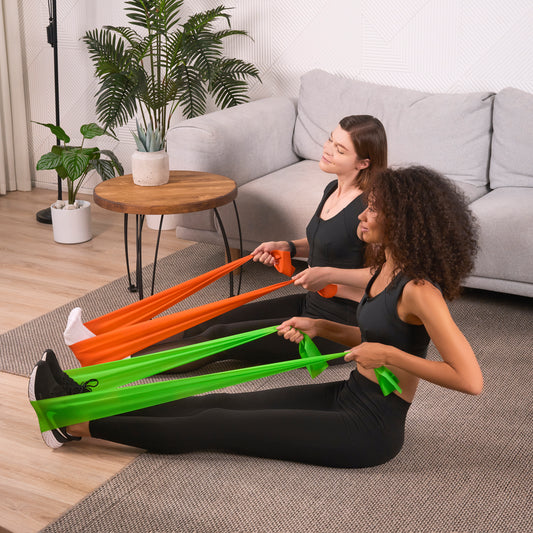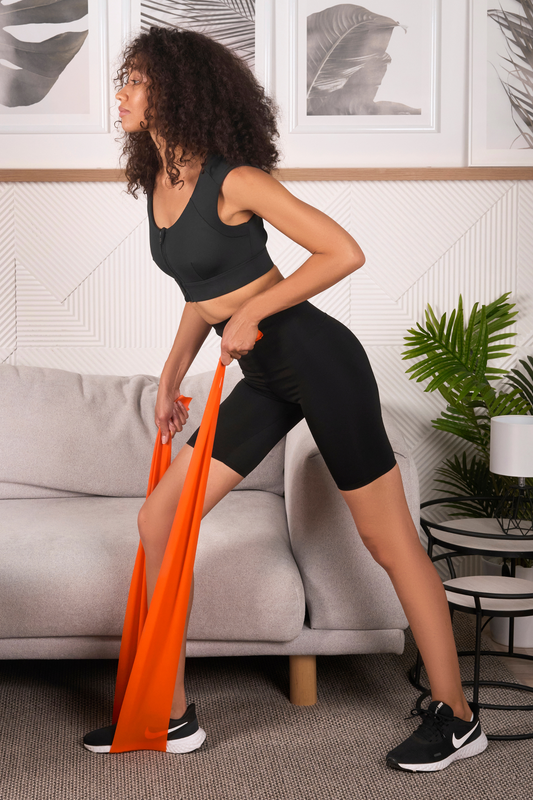Your spine is strong, flexible, and able to withstand a whole lot of pressure. A lot of this is due to its natural curves. When you hear “stand up straight!” you may envision a Barbie-like rigidness, but this is far from reality.
We each have a slightly different degree of curvature in the spine, but when that curvature goes beyond a healthy range it can lead to lordosis and cause discomfort, pain, and other more serious issues.
Think you have lordosis? Keep reading to learn more about this common postural condition and specific exercises to reduce lordosis.
What Is Lordosis?
Lordosis (also known as hyperlordosis) is marked by an excessive inward curvature of the spine. Cervical lordosis refers to the curvature in your neck while lumbar lordosis refers to the lower back.

The best way to visualize lordosis is to think about the position of the head and pelvis. A small amount of lordosis is normal, but when it becomes exaggerated — when you stick your chin out (see: forward head posture) or tilt your pelvis too far forward (so it looks like you’re sticking your bottom out) — it can start to impact how you hold yourself and how you feel.
Common Causes & Symptoms of Lordosis
Lordosis is most common in young children (who often grow out of it) and women — particularly during and after pregnancy — but it can also show up in people who sit a lot.
Lordosis is often a result of muscular imbalances, most commonly a weak core along with tight hip flexors (what you use to lift your legs forward) and tight back extensors (what you use to arch the back). This leads to an increased pelvic tilt, which restricts movement of your lower back.
Symptoms of lordosis can include:
- Swayback posture
- Extra space beneath your lower back when lying down
- Neck and/or back pain
- Sore shoulders and tension headaches (cervical lordosis)
- Restricted range of motion
- Nerve problems (sometimes leading to pain that radiates into the legs and feet)
How Exercises Can Help Correct Lordosis
In general, lordosis can be corrected through exercise, particularly with movements that target the core, hips, glutes, and hamstrings. According to one study, exercises that strengthen these areas can help improve lordosis by pulling the pelvis back into its proper alignment. This can help reduce pain and increase ease of movement (1). Another study found that stabilization exercises are especially helpful in improving lordosis (2).
Let’s take a look at some effective exercises to help with lumbar lordosis.
Corrective Exercises for Lordosis
These are some of our favorite lordosis treatment exercises to target key areas, including the abs, hip flexors, glutes, and hamstrings.
1. Planks
Everyone’s favorite core burner, the classic plank can be done just about anywhere. It’s a full-body exercise that helps strengthen the abs, glutes, shoulders, and upper back.
To do a plank:
- Lie facedown and push yourself up onto your palms and toes.
- Keep your body in a straight line, from your head to your feet.
- Engage your arms, abs, and glutes.
- Lengthen the back of your neck, soften your throat, and look down at the floor.
- Keep your chest open and your shoulders back.

Hold the plank for at least 30 seconds. Increase the time in increments of 10 seconds as you get stronger.
2. Pelvic tilts
This small pelvic movement can be done on the floor or with a chair or exercise/stability ball. It strengthens and stretches the abs, glutes, and back extensor muscles.
To do a pelvic tilt:
- Lie on your back on the floor with your knees bent.
- Tighten your abs to press your back against the floor.
- Tilt your pelvis up slightly away from the ground but make sure your spine remains on the ground. Hold for about 10 seconds.

On an exercise ball or chair:
- Sit on the exercise ball with your feet about hip-width apart. Make sure you’re able to sit on the ball with your knees at a 90-degree angle and your feet flat on the ground.
- Contract your abs, tilt your hips back, and round your lower back. You should feel like you’re bringing your pubic bone to your navel. Hold for 3-5 seconds.
- Now tilt your hips forward and arch your back so that your bottom is sticking out. Hold for 3-5 seconds.
We recommend repeating each movement 10 times for 3 sets.
3. Abdominal crunches
When your core is weak, you’ll often make up for it by tilting the pelvis too far forward. Simple crunches with a focus on the transverse abdominis (the muscle that wraps around the trunk and spans from the ribs to the pelvis) can help improve your pelvic alignment.
To do ab crunches:
- Lie flat on your back with your knees bent and feet flat on the ground.
- Place your hands behind your head.
- Inhale and as you exhale, pull your navel in toward your spine — this movement engages the transverse abdominis (TA).
- To crunch, lift your head and shoulders a few inches off the ground, keeping your TA engaged. Try not to crank your head forward.
- Return back to the floor.

Repeat at least 10 times for 3-5 sets.
4. Dead bugs
Before or after your crunches, try this stabilizing exercise, which also targets the transverse abdominis as well as the hip flexors.
To do a dead bug:
- Lie flat on your back and lift your legs up into a table top position with knees and hips bent at a 90-degree angle.
- Lift your arms so that they are pointing directly up.
- Inhale and as you exhale, pull your navel inward toward your spine without moving your hips.
- Simultaneously lower your left arm overhead and extend your right leg forward. Lower each to about 5 inches from the ground.
- Return your arm and leg to the starting position and do the same on the opposite side.

Repeat at least 10 times for 3-5 sets.
5. Glute bridges
Remain on the floor for this exercise, which targets the glutes, hamstrings, and lower back. This one feels good, we promise!
To do a glute bridge:
- Lie on your back with your knees bent at a 90-degree angle and your arms against the ground at your sides. Keep your feet flat on the ground and shoulder-width apart. Your heels should be at least six inches from your bottom.
- Push into the ground with your feet, squeeze your glutes, and lift your hips to make a straight diagonal line from your knees to your shoulders.
- Hold for 3-5 seconds and return to your starting position.

Repeat at least 10 times for 3 sets. For an extra challenge, loop a resistance band above your knees. Keep the band taut as you lift.
6. Hamstring curls
Many of us suffer with tight hamstrings, and sitting is one of the main culprits. Your hamstrings should be both strong and flexible to support optimal alignment in the pelvis. For this exercise, grab a resistance band.
To do a hamstring curl:
- Secure a resistance band around a sturdy object.
- Lie flat on your stomach. Position your feet about one or two feet away from the sturdy object.
- Loop the band around your ankle.
- Bend your knee as you pull your foot toward your bottom. Try to keep both hip bones on the ground and focus on only moving the active leg.
Repeat for 10-15 reps on each leg for 3 sets. You can also use the resistance band to help stretch the hamstrings with active postures like a seated forward bend.
7. Side plank
Side planks strengthen the obliques, core, and lower back, promoting spinal stability and reducing excessive curvature in lordosis.
To do a side plank:
- Lie on your side with your legs stacked and your elbow directly under your shoulder.
- Engage your core and lift your hips off the ground, forming a straight line from head to feet.
- Hold for 20–30 seconds, then switch sides.
- Perform 2–3 sets per side.

8. Hip Extensions with Drawing-In Maneuver
This exercise strengthens the glutes and core while promoting pelvic stability—essential for correcting lordosis and reducing excessive spinal curvature.
To do a hip extension with drawing-in maneuver:
- Lie face down with your hands resting under your forehead.
- Engage your core by pulling your belly button toward your spine.
- Slowly lift one leg off the ground while keeping your pelvis stable and your lower back neutral.
- Lower back down and repeat 10–12 times per leg.
- Perform 2–3 sets.
9. Superman Exercise
The Superman pose helps strengthen the back extensors, counteracting the effects of an exaggerated lumbar curve in lordosis.
To do a Superman:
- Lie face down with your arms extended forward and legs straight.
- Engage your core and lift your arms, chest, and legs off the floor simultaneously.
- Hold for 3–5 seconds before slowly lowering back down.
- Perform 10 reps for 2–3 sets.

10. Dead Bug Exercise
A great lordosis workout move, the dead bug improves core engagement while teaching control over pelvic positioning.
To do a dead bug:
- Lie on your back with arms extended toward the ceiling and knees bent at 90 degrees.
- Engage your core and press your lower back against the floor.
- Slowly extend your right arm and left leg toward the floor, keeping your core tight.
- Return to the starting position and repeat on the opposite side.
- Perform 10–12 reps per side for 2–3 sets.

Source: yorkvillesportsmed.com
These lordosis exercises target the core, glutes, and lower back to help stabilize your spine and encourage better posture. By incorporating them into your daily routine, you can work toward correcting lordosis and reducing discomfort over time.
Best Ways To Treat Lordosis
For most people, lordosis should not cause any major disruptions to everyday life. You should be able to move and exercise as usual. In fact, your symptoms will likely improve if you stay active. However, if you continue to sit and stand with poor posture, it could get worse and cause pain and limited movement.
You can correct lordosis by enhancing your core strength and addressing muscular imbalances around the lower back, hips, glutes, and hamstrings. Don’t forget to stretch as well! Prolonged sitting can cause tight hip flexors and hamstrings, which can contribute to lordosis and a decrease in range of motion.
Correcting Poor Posture and Lordosis
Lordosis is rather common and can easily be corrected with a little dedication. Start with the six exercises for lordosis above and try to do these daily. Also, try wearing a posture correcting bra for lordotic posture, especially during long periods of sitting. A device like the Etalon posture bra can help promote good posture by gently pulling the shoulders back to open the chest and stabilize the spine.
As you become stronger and more mindful of your posture, you’ll notice less slouching, less pain, and a more confident you.
SOURCES:
- Journal of Physical Therapy Science. Effects of abdominal drawing-in during prone hip extension on the muscle activities of the hamstring, gluteus maximus, and lumbar erector spinae in subjects with lumbar hyperlordosis. https://www.ncbi.nlm.nih.gov/pmc/articles/PMC4339143/
- Journal of Physical Therapy Science. Effect of the Individual Strengthening Exercises for Posterior Pelvic Tilt Muscles on Back Pain, Pelvic Angle, and Lumbar ROM of a LBP Patient with Excessive Lordosis: A Case Study. https://www.ncbi.nlm.nih.gov/pmc/articles/PMC3944314/
FAQs
1. What are the best exercises to correct lordosis?
2. How often should I perform exercises for lordosis to see improvement?
3. Can exercises for lordosis completely eliminate back pain?
4. Can strengthening the core really help correct lordosis?
5. Are there any exercises I should avoid if I have lordosis?
Trending
Try Etalon posture improvement products
